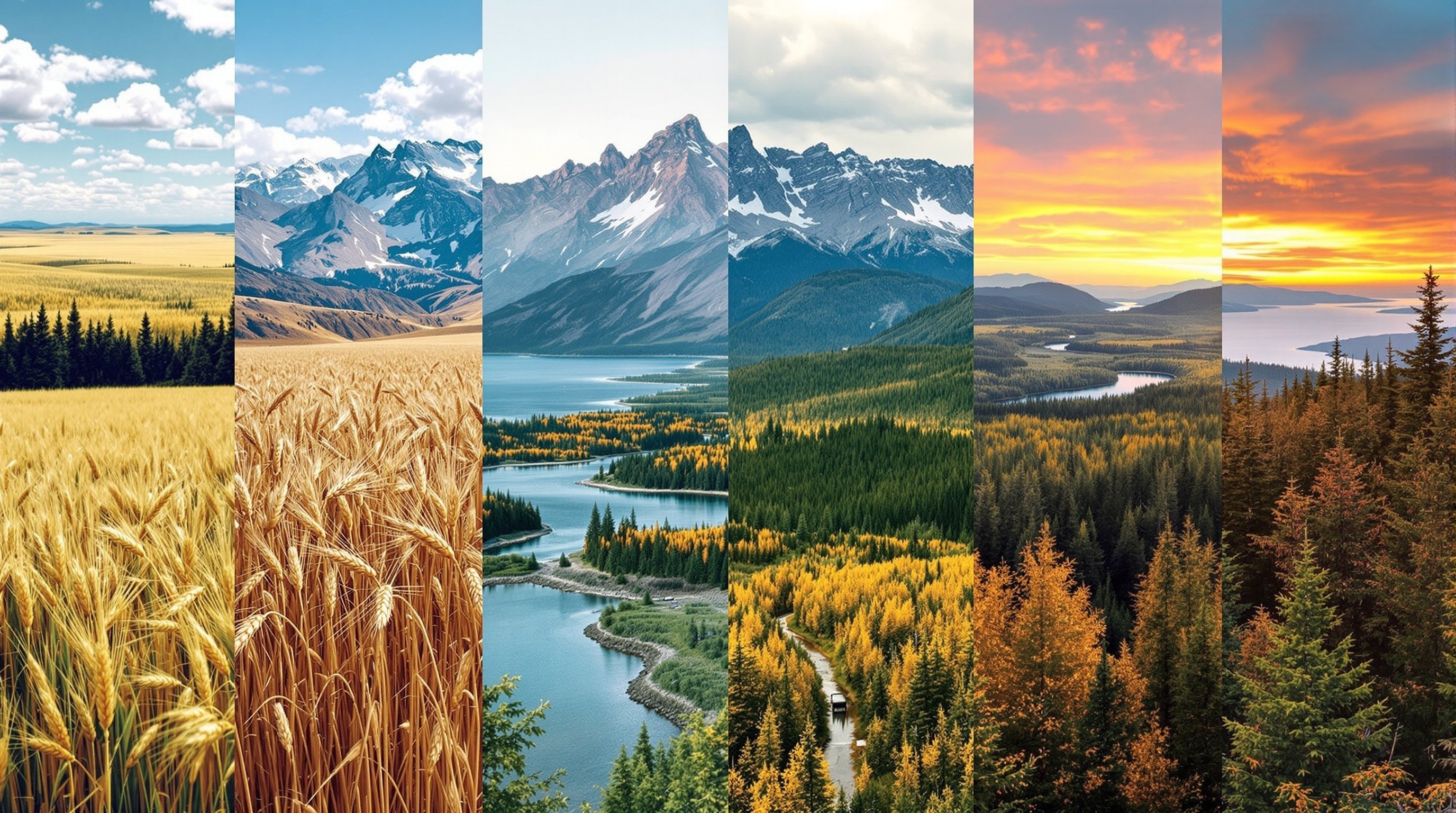Cultural Landscapes of Canada: Regional Identities from Coast to Coast to Coast
Journey through Canada's diverse regions, each with its unique cultural identity shaped by geography, history, and the communities that call these places home. From maritime fishing villages to prairie wheat fields, from mountain valleys to Arctic tundra.

Canada's vastness is more than geographical—it's cultural. Spanning nearly 10 million square kilometers and six time zones, this country encompasses landscapes so diverse they might as well belong to different planets. But it's not just the physical geography that varies; each region has developed its own distinct cultural identity, shaped by the interplay of land, climate, history, and the people who have called these places home for generations.
The Atlantic Provinces: Where Land Meets Sea
In the Maritime provinces of Nova Scotia, New Brunswick, and Prince Edward Island, plus the rugged island of Newfoundland and Labrador, culture is inextricably linked to the ocean. Here, the rhythm of life follows the tides, and communities have developed around harbors that have sheltered fishing boats for centuries.
"The sea is in our DNA," explains Mary MacLeod, a third-generation lobster fisher from Cape Breton. "My grandfather read the weather in the waves, my father taught me to respect the ocean's moods, and now I'm teaching my daughter. It's not just what we do—it's who we are."
Maritime culture celebrates this relationship with storytelling traditions that rival those of Ireland and Scotland—no coincidence, given the region's Celtic heritage. Kitchen parties, where neighbors gather for impromptu music sessions, transform ordinary evenings into celebrations of community and tradition. The fiddle and the sea chanty remain as relevant today as they were two centuries ago.
"In Newfoundland, we don't just have weather—we have 'weather stories.' Every storm, every calm day, every change in the wind becomes part of our collective memory. The landscape shapes not just how we live, but how we remember." — Tom Dawe, Poet Laureate of Newfoundland and Labrador
Quebec: La Belle Province and Cultural Fortress
Quebec represents perhaps Canada's most distinctive cultural landscape, where French heritage has been preserved and evolved over four centuries. From the cobblestone streets of Old Quebec City to the cosmopolitan boulevards of Montreal, Quebec culture reflects a unique blend of European sophistication and North American pragmatism.
The province's cultural landscape is shaped not just by language but by a particular approach to life that values both tradition and innovation. The concept of "joie de vivre"—the joy of living—permeates everything from the province's renowned culinary scene to its vibrant festival culture.
"Quebec is proof that you can maintain your cultural identity while embracing modernity," notes cultural historian Dr. Marie-Claire Bouchard from Université Laval. "Our sugar shacks serve traditional maple syrup in the spring, but they also host contemporary art exhibitions. Our folk music festivals feature both ancient ballads and modern interpretations. We don't preserve culture in a museum—we live it."
The Rural-Urban Cultural Dynamic
Quebec's cultural landscape also illustrates the ongoing dialogue between rural traditions and urban innovation found throughout Canada. In the Charlevoix region, artists' studios occupy century-old barns, while in Montreal, traditional pea soup is reimagined by internationally trained chefs. This tension between preservation and evolution defines much of Canada's contemporary cultural identity.
Ontario: The Cultural Crossroads
As Canada's most populous province and home to the national capital, Ontario presents a cultural landscape defined by diversity and constant change. From the multicultural neighborhoods of Toronto to the Franco-Ontarian communities of the north, from Indigenous territories to immigrant enclaves, Ontario embodies Canada's identity as a cultural mosaic.
Toronto's Kensington Market exemplifies this complexity—a neighborhood where Portuguese bakeries share blocks with Caribbean restaurants, where aging hippies browse alongside new immigrants, and where gentrification coexists uneasily with grassroots community organizing. It's a microcosm of the broader Canadian experience of negotiating identity in a rapidly changing world.
"Ontario doesn't have one culture—it has cultures," observes sociologist Dr. Raj Patel from the University of Toronto. "The challenge and the opportunity lie in how these different cultural streams interact, influence each other, and create something uniquely Ontarian—and uniquely Canadian."
The Prairie Provinces: Sky Country and Agricultural Rhythms
Manitoba, Saskatchewan, and Alberta stretch across the heart of North America under what locals call the "big sky"—a dome of atmosphere so vast it dwarfs human concerns and creates a particular relationship between people and landscape. Prairie culture developed around agriculture, but it's evolved into something more complex and nuanced.
The cultural landscape of the prairies reflects waves of settlement—Indigenous peoples who hunted buffalo across these grasslands for millennia, followed by Ukrainian, German, Scandinavian, and other European immigrants who broke the land for wheat farming. Each group left its mark, creating a cultural palimpsest that layers polka festivals over powwows, Ukrainian Orthodox churches over Métis settlements.
"People think the prairies are empty, but they're full of stories," says Indigenous artist and educator Louise Halfe from Saskatchewan. "Every bluff of trees sheltered a family through a blizzard. Every slough reflects the sky where our ancestors saw visions. The land looks simple, but the culture is incredibly rich."
Urban Oases in Agricultural Seas
Cities like Winnipeg, Regina, Saskatoon, Calgary, and Edmonton function as cultural oases in this agricultural landscape, concentrating arts, education, and commerce while maintaining strong connections to rural traditions. The Calgary Stampede exemplifies this blend, transforming cowboy culture into international spectacle while maintaining authentic connections to ranching heritage.
British Columbia: Mountains, Ocean, and Cultural Convergence
British Columbia's cultural landscape is perhaps Canada's most dramatically varied, from the cosmopolitan Pacific Rim culture of Vancouver to the resource extraction communities of the interior, from Indigenous nations with sophisticated artistic traditions to new immigrant communities creating fusion cultures.
The province's geography—mountains that rise directly from the ocean, temperate rainforests, desert valleys—has created distinct regional cultures within the broader BC identity. Vancouver's culture reflects its position as a Pacific gateway, with influences from Asia as strong as those from the rest of Canada. The city's Chinese New Year celebrations rival those of Hong Kong, while its film industry has earned it the nickname "Hollywood North."
"BC is where Canada meets the world," observes cultural critic Sarah Wong from the University of British Columbia. "Our location makes us naturally cosmopolitan, but our Indigenous heritage and natural environment keep us grounded in place. It's a unique combination."
"In the Rockies, you learn humility. The mountains don't care about your deadlines or your stress. They teach you to think in geological time, to find your place in something much larger than yourself." — David Chen, Mountain Guide and Environmental Educator, Banff
The North: Where Culture Meets Frontier
Canada's three territories—Yukon, Northwest Territories, and Nunavut—represent the country's most challenging and culturally distinct landscape. Here, Indigenous cultures that have thrived in Arctic conditions for thousands of years intersect with resource extraction industries, scientific research stations, and the romantic mythology of the North that captures the Canadian imagination.
In Iqaluit, Nunavut's capital, traditional throat singing performances share community center stages with contemporary Inuit hip-hop artists. The cultural landscape reflects both the resilience of traditional ways of life and the creativity required to adapt to rapid social and environmental change.
"The North is not empty wilderness—it's home," emphasizes Aaju Peter, an Inuit lawyer and cultural advocate. "Our culture has been shaped by this land for thousands of years. We know how to live here sustainably, how to find beauty in what southerners see as harshness. The North has much to teach the rest of Canada about resilience and respect for the environment."
Climate as Cultural Architect
Across all of Canada's cultural landscapes, climate plays a fundamental role in shaping community life, seasonal rhythms, and cultural practices. The country's northern latitude means that seasonal variation is dramatic everywhere, creating shared experiences of winter survival and summer celebration that transcend regional boundaries.
From ice fishing festivals in Northern Ontario to cherry blossom celebrations in Vancouver, from maple syrup festivals in Quebec to summer folk festivals on the prairies, Canadian culture is organized around the rhythm of seasons in ways that distinguish it from more temperate countries.
Transportation and Cultural Connection
The famous Canadian problem of distance has shaped cultural development in unique ways. The Canadian Pacific Railway didn't just connect the country economically—it created cultural corridors that allowed regional cultures to influence each other while maintaining their distinctiveness.
Today, the Trans-Canada Highway, the internet, and air travel continue this tradition of connection across vast distances. A fiddle tune learned in Cape Breton might be played at a house party in Yellowknife. A painting technique developed in the Group of Seven's Ontario might inspire an artist in rural British Columbia.
Indigenous Foundations
Underlying all of Canada's regional cultures is the fundamental truth that this country was home to sophisticated Indigenous civilizations long before European contact. Each region's contemporary culture bears the influence of Indigenous peoples who developed place-based knowledge systems over millennia.
From the maritime expertise of the Mi'kmaq to the prairie wisdom of the Cree, from the mountain knowledge of the Squamish to the Arctic mastery of the Inuit, Indigenous cultures provide the deepest roots of regional identity in Canada. Contemporary Canadian culture is increasingly recognizing and celebrating these foundations.
The Future of Regional Identity
As Canada evolves in the 21st century, its regional cultures face new challenges and opportunities. Climate change is altering the physical landscapes that helped shape cultural identities. Urbanization is concentrating populations in cities while rural areas struggle to maintain traditional ways of life. Digital communication is creating new forms of community that transcend geography.
Yet regional distinctiveness persists and evolves. A new generation of Canadian artists, writers, and cultural creators continues to find inspiration in the specific places they call home, even as they participate in global conversations about art, identity, and meaning.
Canada's cultural landscapes remain as diverse as its geography, offering different ways of being Canadian that reflect the specific challenges and opportunities of place. From the fog-wrapped coasts of Newfoundland to the northern lights of the Arctic, from the rolling wheat fields of Saskatchewan to the towering peaks of the Rockies, the land continues to shape the culture, just as the culture continues to shape how Canadians understand and inhabit the land.
In this vast country, being Canadian doesn't mean being the same—it means belonging to a confederation of places, each with its own story to tell, its own way of being human under the northern sky.

Dr. Priya Patel
Cultural Researcher
An anthropologist specializing in Canadian multiculturalism, Dr. Patel provides academic depth to our cultural analysis. Her research focuses on how immigrant communities maintain traditions while adapting to Canadian life.